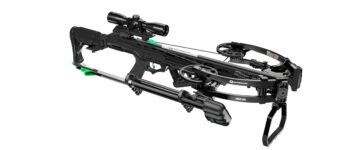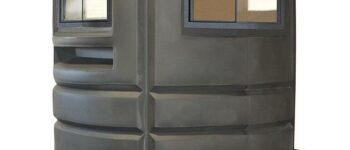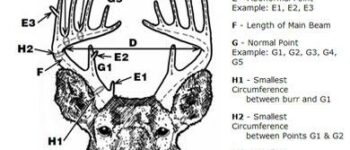
The power of a bow is determined by its peak draw weight and arrow draw length, measured in pounds and inches, respectively. Folks often make the mistake of purchasing a bow with a maximum draw weight they can comfortably pull back while standing in the shop. They don’t realize that during a hunt — sitting in a tree stand on a cold day, bundled up in bulky clothing — they probably won’t be able to smoothly pull back the bow for two reasons. First, it’s harder to come to full draw when sitting versus standing. Second, even when standing, your muscles don’t work as well in cold weather.
By Bob Banfelder
The staff at a good pro shop should sit you on the floor, hand you a bow in the 50-pound draw-weight range and have you work your way up or down the scale from there. If you strain to handle a 60-pound draw weight when sitting, even when using a mechanical arrow release, that bow is not for you. You must back down to a comfortable draw weight while sitting.
Don’t be macho. I’ve seen over-the-counter sales personnel sell bows that were far beyond a customer’s capability to handle at an archery range, let alone the woods. Note that you can effectively kill deer with a 40-pound draw-weight bow. As a rule of thumb, 40 pounds of kinetic energy efficiently kills whitetails, and 50 pounds or greater is required for larger game such as elk, moose or bear.
When I bought my first Mathews bow, it had a 70-pound draw weight. I had no trouble pulling the bowstring back with the aid of a release — standing in the store. Standing in shirtsleeves in the back yard or my club’s shooting range, I experienced no problems. I could shoot that bow all day — and have. Also, because the start of archery season in my area is generally warm, I had no trouble coming to full draw when sitting or standing in a stand. However, when cold weather finally arrived and I was bundled up in bulky clothing, my muscles did not work the same. I could not come to full draw smoothly. Not good. However, all was not lost. I simply backed off the recommended five turns on the bow’s limbs with a T-tool, which reduced the draw weight by 10 pounds. I was good to go. Or was I?
As the years progressed and I aged, I noticed I was experiencing some difficulty in coming to full draw while sitting when hunting, so I started to stand. No big deal. I stand much of the time anyhow. When I grew tired, I sat. Then, one late afternoon, a nice buck appeared beneath my stand while I was sitting. I tried to come to full draw. I didn’t have buck fever (nervousness). I slowly rose to my feet. The buck made me in an instant and was gone in a nanosecond. That was in 2011.
Practical Fix It is important to remember that the draw weights of most bows can be backed down about 10 pounds. If you can comfortably handle the maximum draw weight of a bow while sitting, with the ability to back off 10 pounds, that model might be for you. However, that depends on an important factor. Older compound bows — such as my first Mathews, purchased in the mid-1990s — don’t perform as well when cranked down 10 pounds from their maximum draw weights.
Newer models do because technology has improved dramatically. Today’s bows are far more forgiving. So, if you purchase a 70-pound pull bow today but have trouble coming to full draw tomorrow, you can simply decrease the draw weight by 10 to 12 pounds and expect solid performance. Do not try to save money by purchasing a used bow that’s several years old.
After thorough research in 2012, I bought a Mathews Z7 Magnum Solocam bow with a 50-pound maximum draw weight. My old Mathews, maxed out at 70 pounds, is 64 percent to 65 percent efficient. When you back off 12 pounds, the efficiency drops to 55 percent. When you drop from 50 to 40 pounds with the Z7 Magnum, the efficiency rating drops only 1 percent. As I get older and might need to reduce the new bow’s draw weight, the loss of efficiency will be negligible.
Admittedly, I’m a dinosaur, having shot aluminum arrows and fixed-blade broadheads for more than a decade and a half. I recently graduated to far lighter and faster carbon arrows and mechanical blades when I purchased the new bow. By doing so, the overall performance of the new bow actually came close to that of the 70-pound-pull bow, as recorded by a chronograph, which measures the speed of an arrow in feet per second.
Remember, a bow with a maximum draw weight of 70 or even 60 pounds is a lot to pull back smoothly for the average person, especially when hunting in cold weather and particularly when sitting. Again, you do not want to be in a tree stand with a trophy buck beneath you and be unable to pull your bow back smoothly — or at all.









